|
A LITTLE ABOUT GOAT PACKS
Sawbucks, Soft Packs, Day Packs, Goat Packs, Dog Packs.... There are many types of packs that folks use on their goats. One thing is for sure, there are as many opinions on the BEST goat pack as their are people that use them.
Before throwing a pack on your goat and heading out for the week end, there are a few things you might want to know. Things like types of packs and why one might be better then another. What about padding, how to care for the pack, repair the pack and comfort of the goat, and padding for sawbucks....(more to come soon, very soon).
Types of Goat Packs
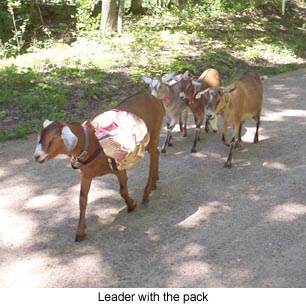
SOFT OR DAY PACK
A Soft or Day Pack is used for short trips with light loads. Usually this is an all one piece item. The packs are attached to the yoke and usually they have a top that closes for securing the items you will carry. Keep the panniers on this and all packs for animals the same weight on each side.
For some people and their goats this is the only type of pack they will ever need. These packs are great for day, lunch or family hikes that are 10 miles or less and done in a days time.
This type of pack is a good way to get started packing with goats. It is inexpensive and you can get a feel for packing with goats. While this pack should only be used for light loads, you can sure have a lot of fun on day trips and or lunch trips with a pack like this one.
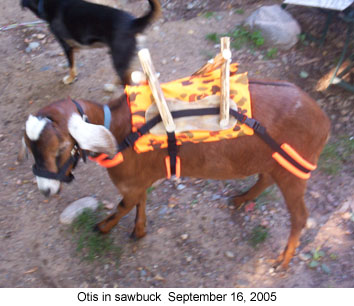
SAWBUCK
These Sawbuck Saddles are modeled after the old mule packs. The Sawbuck Saddle (seen in this picture) is used for heavy loads over many miles. The Sawbuck sets the weight up off the goats spine. The panniers are separate from the saddle and each one hooks over the top X. You always want to pack panniers the same weight so that the load is balanced on both sides.
Sawbucks need to fit the animal. It is not a good idea to use a llama sawbuck or a donkey sawbuck on a goat. The sawbuck saddle is made to fit the animal's body for the most comfort as they pack. Just because the package says "made for a goat" does not mean it will fit your goat. Just as horses need a saddle that fits their backs, a goat needs a sawbuck that will fit their back correctly too.
Note in the photo the saddle padding under the wood. Never use a sawbuck on an animal without thick padding or a thick saddle pad. (see below about sawbuck padding)
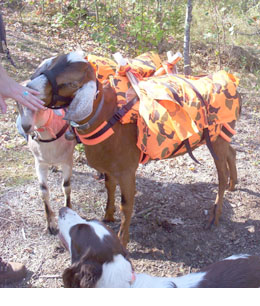
SAWBUCK PANNIERS
Every sawbuck needs panniers or packs. Panniers are individual packs that hook, tie or fit over the sawbuck. Most packers will want panniers that close shut as the pack will rock when the goat walks and the items will be more secure in a closed top pannier.
Panniers come in different sizes and fabric types. Measure your animal with the sawbuck on them before ordering (or making) their new panniers. Panniers that are too big are uncomfortable for the animal. The humans also have a habit of over packing those too large panniers too.
When choosing your fabrics waterproof is always a great idea.
You can also use buckets in lieu of panniers. You will need a special strap set up for the buckets to be carried comfortably and safely by your goat. The bucket can also double for a seat or table in camp.
SOFT SADDLE PACK
This type of pack is a cross between the sawbuck and a daypack. It keeps the load up off the spine of the animal but does not have the rigid saddle that the panniers hang from.
This saddle can not be over packed and must be maintained so that the fibers in the cushion do not break down letting the load come down on the goats spine. You may or may not need a saddle pad for this type of pack, depending on the build of the pack itself.
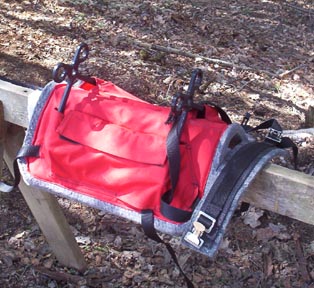
CUSTOM FIT SADDLE
I borrowed this Saddle Pack from a good friend of mine, Sally, for photos. It is called/named as a Custom Fit Saddle. The mold to make the saddle was formed using a goats body. Sally has her Custom Fit saddle tucked away in the cushioned Pocket Pad that she bought along with the saddle.
Just like the Sawbuck, the panniers are separate. On this saddle the panniers would hook to the O's on the saddle. Always pack panniers the same weight.
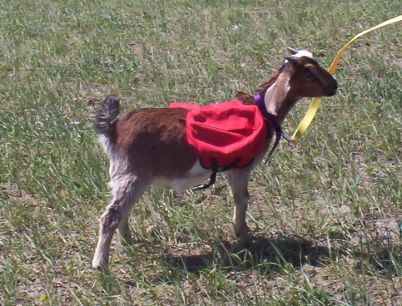
DOG BACKPACKS
Some Dog Packs can and do work for goats. Be sure if purchasing one that the straps are very long so that they can be adjusted to fit goats. Dogs are bigger in the chest and smaller in the stomach area, goats are the opposite. Many times the manufacture will cut the back straps short. You may have to cut the straps if they are the folded over type and will not adjust small enough for a goat.
Dog Backpacks should be loaded and use the same way as the daypack, they are much the same.
This photo of Amos was taken when he was three months old. There is no load in the pack. He is wearing it to learn to have straps and fussing all about his body and to get used to the feel of a pack on his back. Please do not put a load on a goat that is too young to carry one.
STRAP ONLY YOKE PACKS
Well? I thought these were a thing of the past, but then, recently, on a goat site I saw them for sale. I do not have a photo because we use our own photos on our sites and I would never own a Strap Only Yoke Pack for dog or goat. They are unsafe and can cause serious health problems.
What is a Strap Only Yoke Pack? It is two panniers held on the animal by two sometime three straps across the back.
Why are they so bad? These type packs put all of the weight of the pack on just a couple of vertebra. These packs can actually push the vertebra of the animal out of alignment. They are hard on the spine, they are not safe on the trail. The straps can also and have been caught by branches as the animal walked down a "tight" trail. I know. I was there when a friend had these types of packs on her dogs.
Please, do not use this type of pack on your dog or your goat or any other species of animal.
Keep Your Packs and Equipment Maintained
You must take care of your equipment and check it often for wear, holes, frays, build up of dirt, burns or other stresses to seams or the like. If that pack or pannier breaks on the trail, guess who will be pickup up the equipment and carrying it back to your vehicle?
You should really take a few minutes and check your packing gear while on the trail at camp. It will only take a minute and may save you hours. Just do a quick check over and run your finger over the inside seams of your packs. Always carry a sewing kit with you but make sure it is in a good thick plastic container that closes tightly so that needles do not get loose in the pack and hurt someone. Empty vitamin jars are great for this. Duct tape can also be very helpful if your saddle, straps or even seams break or come loose.
When you get home from your trip, even a short little lunch trip, check your equipment over really well. Check all of your buckles, buckle holes, and or places where the webbing or straps are stressed as the animal walks the trail. Clean your equipment up, some packs might need a good machine washing, others just wiped over, check it out and store it correct. Packing equipment is not only expensive, it needs to be where you can find it and ready to go when you are.
You should also check your equipment when you pull it out to use again. You never know when a sneaky little mouse may get into things and build nests, chew and destroy items.
Repairing Your Packs and or Panniers
If you repair your own packing equipment be sure to really nail down your seams. Double stitching may not be enough. Packing trips can really be hard on some equipment with some animals. Some packs will be scrapped on trees, chewed at, gone through water crossings, and usual wear and tear. Keep in mind the wear that the type of pack/panniers will be receiving and repair accordingly.
If you patch a pannier, cut your patch out of heavy duty fabric as close to matching the fabric as you can. I fold the fabric over, double it, for the patch. Place the patch inside the pack and pin it into place covering the hole, it should have plenty of room on all sides of the hole. Sew it in place from the outside of the pack over where the hole is, tucking your pannier fabric under (where the hole is) as you sew so that the pannier will not fray any further. You might need to clip the corners of the hole on the pannier for this. Sew it at least double then go right along the fabric edge with a zig zag stitch. Now sew the inside of the patch (sew from the other side of the pack). Double your patch over where necessary and tuck it under as you sew it on so that it too does not fray. Sew it down close to the ends of the patch. Zig Zag it too, on all edges, this helps keep items from rubbing it when the goat walks with a load in it. If it is a large patch sew an X across the entire patch for stability.
Don't think of your patched pannier as worn and torn, think of it as broke in and has character! Patches on panniers are like scars on the body, like tattoos only with a better stories!
Sawbuck Padding or Pads
As with sawbuck saddles, there are many opinions on pads for the same. But you will need some sort of padding between the sawbuck saddle and the goat. Be sure to understand the differences in padding, just as you would for a horse saddle pad.
Many sawbuck saddles come with padding. Some don't. Some people use a pony saddle pad or blanket and others use rugs.
Attached padding is the easiest, and most effective padding. It will cover the sawbuck it came with, pad where needed and is easy to store and find when you are ready for your next packing trip. But be warned that not all attached padding is the same. Some is easy to use, other requires cramming your saddle and smashing your fingers into the compartment that the sawbuck saddle rides in. Some attached padding is made of carpet pieces, and that is fine if it is a nice thick piece and it might work alright....til it gets wet, or needs cleaning.
A pony or other sawbuck saddle pad may or may not fit the goat correctly. The pad needs to fit correctly or the saddle will not stay firmly as comfortable as a well fitting pad will keep it. What often happens is that a poor fitting saddle blanket will require the saddle to be more firmly <read down right to tight> cinched up around the goat to hold it in place. Most pony pads will be a bit big for an average sized adult weathered dairy breed goat.
A small blanket or rug folded just right can make a usable sawbuck saddle pad. But again, it needs to be the right thickness and size. You do not want an absorbent fabric that will soak up rain and or stream water to make the goat uncomfortable and even give the goat saddle sores as the pack sways with the goat's movement.
I wish you all a great friend a packing buddy as I had/have in my husband Deron and good friend Sally! I also wish you well behaved, strong, fun loving goats with big personalities to keep you in good humor at camp!
| 



 In the high plains of South Dakota, USA
In the high plains of South Dakota, USA In the high plains of South Dakota, USA
In the high plains of South Dakota, USA